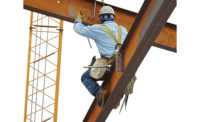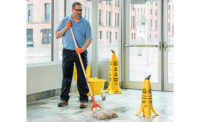The first step to selecting the ideal solution for both fall protection and access is to choose from several available equipment types, including safety bridges, safety stairs, loading racks and platforms. The second: ensuring the selected solution is flexible and customizable.
Access and equipment
The most difficult transition during the loading and unloading process occurs when the worker moves from climbing up a ladder to get to the top of a vehicle. Equipment is designed to, first, safely maneuver workers to the proper height of the vehicle and, second, provide access and fall protection while they work on the equipment.
Safety bridges (gangways)
Railcar and tank truck safety bridges, also called gangways, are designed for various industries and applications that require access to the top of a vehicle, specifically where the working range is within 15 degrees above or below the platform height. They provide safe access from the loading rack or dock to an elevated manway during loading and unloading processes. The safety bridge is maneuvered by hand, with a slight push or pull positioning the bridge for safe access, and it can be paired with a safety enclosure for operator fall protection.
Safety bridges feature carbon steel, aluminum, fiberglass or combination construction, and should be selected according to environmental requirements. To ensure optimal protection, purchasers should choose a safety bridge designed with non-skid grip strut walking surfaces. Other desired features may include folding tubular handrails with midrails on each side of the stair for increased operator safety, as well as neoprene bumpers to eliminate damage to the serviced vehicles.
Safety stairs
When the working range involves angles greater than 15 degrees above or below the platform height, safety stairs can provide safe access from the loading rack or dock to an elevated walkway. Stairs may also be partnered with a safety enclosure, which can be easily attached to the access equipment for enhanced operator protection.
Operation and material options for safety stairs are similar to that of safety bridges. Optional features include adjustable chain stops that allow access equipment to be self-supporting and a slide-track with carriages for adjustable access.
Loading racks
Loading racks are designed to facilitate access to vehicles such as isotainers and tanker trucks that may need to be loaded in harsh outdoor environments. Featuring heavy-duty construction and engineered for operator safety, loading racks may be equipped with safety bridges, safety stairs or another access option. Full or half canopies are available to protect against wind and precipitation, depending on whether loading and unloading takes place on either both or just one side of the rack.
Single pedestal platform racks, equipped with an access stairway and equipment, are available for fast access and fall protection to the top of a single-dome tank/bulk trucks, tank cars and hopper cars. Removable models eliminate the need for costly foundations. Installed with counterweights positioned on supports on the unit, these models provide an ideal solution for companies with temporary loading stations. Featuring no underground anchors, racks can be easily removed, loaded on a truck and moved to another facility.
Platforms
Portable platforms are another option for applications that require limited use of access and fall protection equipment, or where the environment doesn’t support permanent truck loading platforms and foundations. Offering an adjustable height range, portable platforms provide operators with a rugged loading area and can be used as a maintenance work platform.
Providing a push-button operated, self-supporting platform, elevated platforms allow access to tank/bulk trucks without the need to rest on top of the vehicle during loading and unloading. Paired with railing fall protection for all typical ports on a tanker truck and optional canopies, elevated platforms offer robust steel construction for weather and corrosion resistance.
Customization options
Manufacturing and chemical processing plants that require access and fall protection equipment vary greatly, and few companies load and unload just a single type of vehicle for all their operations. Due to this, flexibility and customization are key. Adjustable reach gangways can be selected to allow operators to simply and safely access vehicles of different heights and lengths. Further, the safety stairs with a slide-rack can be implemented, moving to the left and right to ensure operators reach mis-spotted rail cars and trucks.
When a plant regularly requires solutions beyond standard, many cost-effective customization options are available — from oversized walkways to extended canopies.
Further, customizations can be planned to work around existing equipment. For example, a company may have an issue with loading and unloading due to existing piping and loading arms. A custom solution can make sure the required fall protection exists, and it does not come into contact with existing equipment when being lowered and raised. By selecting a flexible and customized solution, sufficient fall protection can be achieved without restricting access, suiting a broad range of application requirements.




